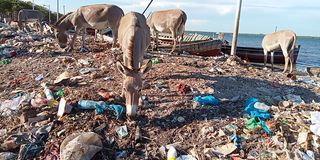Lamu collects 1,000 tons of garbage, plastics as 45-day clean-up exercise ends

Dirty beaches and stuffy dumpsites in Lamu. Locals have decried poor garbage collection in Lamu.
Over 1,000 tonnes of garbage were collected in various parts of Lamu Old Town in a clean-up exercise that has been ongoing for the past 45 days.
The campaign, which ended Thursday, was introduced in early November and sought to fight the poor plastic and other solid waste disposal in the old town’s beaches, a Unesco World Heritage site.
The project dubbed Sustainable Tourism at World Heritage Sites was sponsored by the Unesco Regional Office for Eastern Africa in partnership with the National Museums of Kenya (NMK), the Kenya Tourism Board (KTB), the local governments, and community-based organizations.
Speaking to Nation.Africa during the closure of the exercise, NMK Curator in charge of Lamu Museums and World Heritage Site, Mohammed Ali Mwenje said the initiative created job opportunities, particularly for communities living around Fort Jesus in Mombasa, a well-known heritage and tourist attraction site and Lamu Old Town World heritage site.
The Lamu Old Town and Mombasa Fort Jesus were the project’s focused sites.
Mr Mwenje said in Lamu, the initiative involved collecting plastics and other solid waste from beaches, and open public spaces, and the general maintenance of clean surroundings for sustainable tourism.
Rehabilitation and relocation of illegal dumpsites within the historical city were also part of the initiative.
The campaign also sought to ensure there is a total ban on single-use plastics in Lamu Old Town.
Key careless waste disposal hotspots that were mapped and worked on during the 45-day period included Mkomani’s Kanu office area, Tundani and Domoni dumpsites, the Langoni historic graveyard, and the Old Town seafront.
Mr Mwenje thanked all the stakeholders that came out to lend a hand and ensure the exercise is a success.
“When Covid-19 struck, it affected people’s economy and livelihoods. Many lost their jobs and there was poverty everywhere. Unesco regional office for eastern Africa opted to come up with this initiative that created job opportunities for the communities that fought and ensured there’s zero use of plastics and subsequently sustainable tourism,” said Mr Mwenje.
He added, “Within the last 45 days of a clean-up exercise, we have collected roughly 1,000 metric tons of rubbish and dumped it to the recommended area of disposal.”
He noted that solid waste disposal in the ocean and beaches on Lamu Island have for years posed a big challenge that has many times even discouraged tourists from visiting the archipelago.
He called on the need for candid discussions between the Lamu, NMK, local community members, conservationists, and other stakeholders that will see to it a permanent solution to the plastic waste disposal menace.
“We faced challenges during our 45-day period that almost made us give up. But we thank God that we accomplished the task. There seems to be no working county action plan on matters of plastic disposal. And that’s why the community continues to throw plastic anyhow,” said Mr Mwenje.
He said NMK, the Lamu Municipality, and the county governor, Issa Timamy have already agreed that they set up an ash-pit where people will temporarily be disposing of plastics and other solid waste even as a permanent solution to the menace is being sought.
Lamu Tourism Association (LTA) Deputy Chair, Fridah Njeri thanked Unesco, NMK, KTB, and other stakeholders for coming up with such a clean-up exercise that has left the Old Town sparkling clean.
“As you’re aware, Lamu Old Town is a tourist hub for the county. When it is clean, it attracts many tourists from across the globe to visit and we’re already witnessing this,” said Ms Njeri.





